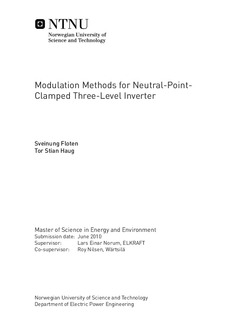| dc.contributor.advisor | Norum, Lars Einar | nb_NO |
| dc.contributor.advisor | Nilsen, Roy | nb_NO |
| dc.contributor.author | Floten, Sveinung | nb_NO |
| dc.contributor.author | Haug, Tor Stian | nb_NO |
| dc.date.accessioned | 2014-12-19T13:52:12Z | |
| dc.date.available | 2014-12-19T13:52:12Z | |
| dc.date.created | 2010-09-22 | nb_NO |
| dc.date.issued | 2010 | nb_NO |
| dc.identifier | 352816 | nb_NO |
| dc.identifier | ntnudaim:5510 | nb_NO |
| dc.identifier.uri | http://hdl.handle.net/11250/256874 | |
| dc.description.abstract | Multilevel converters have seen an increasing popularity in the last years for medium- and high-voltage applications. The most popular has been the three-level neutral clamped converter and still research is going on to improve the control of it. This master thesis was a continuation of the specialization project fall 2009. The main topics of current thesis were to further investigate the DC-bus balancing issues, compare symmetrical (one sampling per triangular wave) and asymmetrical (sampling at the top and bottom of the triangular wave) modulation, derive current equations for Space Vector and Double-Signal, improve output voltage in overmodulation and be able to DC-bus balance, and to implement the methods in the laboratory. Models of the three-level converter were made in the specialization project in both PSCAD and SIMULINK and further studies of the DC-bus balance were also made in this master thesis. None of the methods showed problems to regulate the DC-bus voltage when there was different capacitor values and unsymmetrical load. A PI controller was introduced for Space Vector but it did not show better performance than a regular P regulator. Asymmetrical modulation showed a clearly better performance than symmetrical modulation when the switching frequency was low compared to the fundamental frequency, especially for Space Vector. The 1st harmonic line-to-line voltage was closer to the wanted value and the THDi was significantly lower. Simulations also showed that the THDi can vary significantly depending on at which angle the first sampling is done. This is most clear for asymmetrical Space Vector modulation, but also for the other cases this pattern occurs. By implementing an overmodulation algorithm the amplitude of the 1st harmonic output voltage was closer to what was desired. Simulations showed how important it was to have three phase sampling symmetry in overmodulation. By having a wrong switching frequency the line-to-line output voltage dropped down to 2.06 when operating in six-step, when the wanted output value should be 2.205. Hence there is a quite large mismatch and the converter is sensitive to the switching frequency when it is operating in the higher modulation area. The balancing algorithm introduced for overmodulation is able to remove an initial offset without a notable change the 1st harmonic output. Both Space Vector and Double-Signal were tested in the laboratory with two separated DC-sources. Asymmetrical and Symmetrical modulation were tested and so was also overmodulation. The laboratory results confirmed the simulated results, but since the switching was not synchronized in the laboratory, some errors occurred. | nb_NO |
| dc.language | eng | nb_NO |
| dc.publisher | Institutt for elkraftteknikk | nb_NO |
| dc.subject | ntnudaim | no_NO |
| dc.subject | SIE5 energi og miljø | no_NO |
| dc.subject | Elektrisk energiteknikk | no_NO |
| dc.title | Modulation Methods for Neutral-Point-Clamped Three-Level Inverter | nb_NO |
| dc.type | Master thesis | nb_NO |
| dc.source.pagenumber | 118 | nb_NO |
| dc.contributor.department | Norges teknisk-naturvitenskapelige universitet, Fakultet for informasjonsteknologi, matematikk og elektroteknikk, Institutt for elkraftteknikk | nb_NO |

